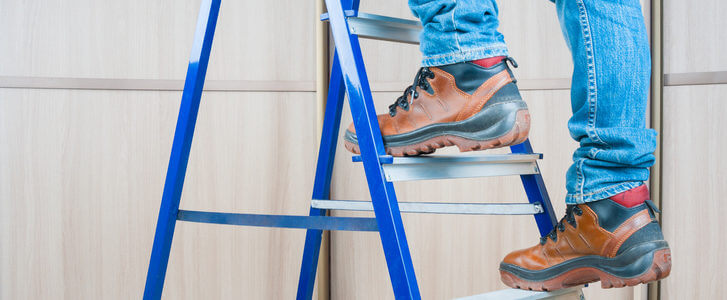Does your job involve using a ladder? Do you know what to do to prevent falling when climbing a ladder?
According to the latest data compiled by the Consumer Products Safety Commission (CPSC) in 2017, falls from stools and ladders caused more than 270,000 emergency room visits, as well as nearly 42,000 hospitalizations and/or deaths. Melanie Leonard, who is the Trauma Program Manager at Medical City North Hills in North Richland Hills, Texas, says the most common types of injuries caused by ladder falls include broken limbs, backs, and pelvises. Head injuries also are one of the most common types of injuries caused by a fall from a ladder.
The key to avoiding these types of injuries is to learn how to prevent falling off a ladder.
Use the Right Type of Ladder
Not all ladders are created equal. Choosing the wrong ladder for a job can lead to an unexpected meeting with a floor or the ground.
Here is a list of commonly used ladders:
- Self Supporting Ladders
- Step-for jobs such as reaching a high cabinet
- Platform- for jobs such as painting or construction
- Dual purpose- for jobs such as roofing
- Multi-purpose- for jobs such as home renovations, small business maintenance needs, or various interior or exterior cleaning projects
- Non-Self-Supporting Ladders
- Extension- for jobs such as cleaning gutters, painting a building, or washing windows
- Single pole- for jobs such as painting or washing windows
Ladders also are constructed to handle different load capacities, categorized by Type:
- Type III-200 pounds
- Type II-225 pounds
- Type I-250 pounds
- Type IA-300 pounds
- Type IAA-375 pounds
Inspect the Area Where You Plan to Work
You should inspect the area where you plan to work for water and clutter. A step ladder might require a board to level the legs and prevent the ladder from sinking into soft ground. Make sure to place a ladder away from any doors that swing open to the outside. Never place any type of ladder on a sprinkler system or pipes that transport harmful chemicals.
Check the Condition of a Ladder
You should work with a ladder that is in mint condition. Loose parts, broken rungs, and cracks along one or both sides can be the ticket to the closest ER. The best time to detect a defective ladder is when you have both feet on the ground.
Stabilize the Feet
Stability is essential for using a ladder. The feet of a ladder should be positioned flat to the floor or ground. For an extension ladder, you can also flip the feet to ensure the pointed tips penetrate the ground to keep the ladder stable. Some ladder models come with levelers to help users adjust to uneven surfaces. You can also twist the rail on some ladder models and then position the ladder according to the position of the surface where you plan to work.
Follow the Four to One Rule
The ideal angle for positioning a ladder is 75 degrees. However, it can be difficult to achieve the correct angle without using the proper tools. Instead, you can apply the four to one rule, which means that for every foot you place the ladder away from its base, you can increase your ladder’s height by four feet. Achieving the optimal angle is one of the most important factors for creating stability for any type of ladder.
Wear Proper Shoes
If you work in the construction, healthcare, or hospitality industries, you understand the importance of wearing slip-resistant shoes. The same principle applies to anyone planning to scale a ladder. Even if there is not any moisture on the rungs, you can still slip and fall off the ladder, particularly if the ladder is constructed with a slick material like aluminum. Wearing slip-resistant shoes gives your feet a better grip with the rungs of a ladder.
You’re Not Scaling a Mountain
Most ladders do not have the proper support capability at the top two rungs. Once you climb the second to last rung to reach the top of a ladder, you significantly increase the chances of falling off the ladder. Make the third to last rung the last rung where you place your feet.
Use Both Hands
Climbing a ladder is certainly not the right time to check text messages or quickly eat a sandwich. When using a ladder, three points of contact should be maintained at all times (two hands and a foot, or two feet and a hand). If you feel your body leaning over to one side, the hand on that side can steady your climb. If you need to carry something up a ladder, plan ahead on how to accomplish that safely.
Work with a Partner
Having someone around while you work on a ladder allows you to climb a ladder with both hands, because the partner can hand you items when you reach the rung where you want to work. You’ll also have someone around to help you in case you fall from a ladder.
There for You: Acadia Insurance
At Acadia, we’re all about helping businesses throughout New England thrive. Our mission is to provide superior service and product as close to you as possible, providing you with the backing you need to proceed with confidence.
We understand what you want most from your insurance is security and peace of mind. That means knowing you are backed by an insurance company who will support you every step of the way to help you protect your business.
With Acadia, not only can you get coverage tailored to your needs, but you will also receive support from dedicated claims professionals to guide you through the claim process in the event of a loss. That way, you know exactly what to expect. Knowing your claims professional by name and a hand shake – that’s “Closer Coverage”. Get to know more about how we work and find an agent near you.
Acadia Insurance is pleased to share this material with its customers. Please note, however, that nothing in this document should be construed as legal advice or the provision of professional consulting services. This material is for general informational purposes only, and while reasonable care has been utilized in compiling this information, no warranty or representation is made as to accuracy or completeness.




